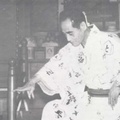Ask any Japanese American enough questions, and you’ll invariably find out that you’re somehow related. You learn that your second cousin went to school with so-and-so’s neighbor, or your friend’s great-uncle used to golf with your dad. It seems like we’re always looking for those ties that bind us together as a community. A common question we JAs often ask is “What Camp were you, your parents, or grandparents in?”
In my case, my mom’s family went from Santa Anita Race Track to Heart Mountain, Wyoming. Literally thousands of people can say that, too. But after a year and a half, my grandma and her five children went to Crystal City, Texas to be reunited with my grandfather, Rev. Masashi Okazaki, a Tenrikyo minister. Not as many people can say that.
Crystal City was different from the 10 WRA-operated U.S. concentration camps. Run by the Department of Justice, Crystal City was considered the “family camp.” Many families were split apart when ministers, J-school teachers and other community leaders were picked up by the FBI, shortly after Pearl Harbor was attacked. Later, families were able to petition out of the WRA camps in order to reunite with their fathers in Crystal City. Germans, Italians and Japanese Peruvians were also interned at Crystal City, making it a very unique multicultural camp.
When people talk about their Camp stories, it usually ends there—where they were, what they were doing, the Reunions they’ve attended, how the Issei suffered, the injustice of it all. But what about “after Camp”?
Well, after the release of some 120,000 JAs from Camp, housing and jobs were scarce on the West Coast. Homeless families were doubled up with friends and relatives in cramped houses, in churches, in make-shift trailer camps, wherever they could find a place. Instead of returning home to Los Angeles in 1945, Mom and her family went out East—to the Far East. At least to them, it was.
They were recruited out of Crystal City to work for Seabrook Farms, a frozen foods company in New Jersey. Seabrook employed roughly 3,000 farm and factory workers, mostly Japanese immigrants. The second largest group were African Americans. Previously, Seabrook Farms had hired German prisoners of war, many of whom returned to Germany after the war.
Seabrook Farms offered an abundance of jobs and housing, which was difficult to find in Los Angeles. I’m sure when my Issei grandparents made the decision to go, they thought this was a great opportunity. Or maybe they thought they had no other choice.
I know little about what my grandparents experienced during their year in Seabrook Farms. I know that my mom was in the first grade. We have some black and white photos of my Uncle Fumio on a bicycle.
I have learned more about Seabrook Farms from Seiichi Higashide’s autobiography, Adios To Tears. Mr. Higashide is a Japanese Peruvian who was kidnapped from Peru. He was interned in Crystal City as part of a prisoner exchange agreement between Peru and the United States, and was unable to return home to Peru after the war. But that’s another story. Like my family, the Higashide’s were also recruited out of Crystal City by Seabrook Farms.
In his book, Mr. Higashide describes Seabrook as a “company town,” which took advantage of its immigrant workers with limited language skills and options. During the peak season, the employees worked 12 hour shifts, for as little as 30 to 50 cents per hour. In slower seasons, the workers were laid off without notice.
Living conditions were worse than they had been in Crystal City. Although the barbed wire was gone, they were still living in barracks, behind chain-link fences. Yet now, they were dependent upon themselves, with Seabrook as their sole means of support. They lived 5 miles from the nearest town and most were without transportation. People shopped at over-priced company-owned stores—putting their hard-earned dollars right back into Seabrook pockets.
Now, fifty years later, we hear about the horrible treatment of the Asian garment workers, who were kept as slaves in El Monte. The first thing that goes through my mind is that this is 1995, not 1945! That doesn’t seem to matter much. These Thai workers, mostly women, endured years of deplorable sweatshop conditions, 15-hour days at well below the minimum wage. Sound familiar? It’s not exactly the same thing, but you can see the similarities.
Both of my grandmothers worked as seamstresses in the garment industry after the war. In 1994, the U.S. Department of Labor published a survey of licensed garment manufacturers. Results showed that over 50% of the companies were paying less than the minimum wage and failed to pay overtime. A whopping 92% violated health and safety codes. Sweatshops such as those found in El Monte were more than likely not included in this survey.
Today, anti-immigrant scapegoating by conservative politicians continues. Immigrants are blamed for causing social problems that have much deeper roots. Things like Prop. 187 taking away the right of undocumented immigrants to education and health services. Or bills like H.R. 2202 (Rep. Lamar Smith R-TX), which keeps people from emigrating to the U.S. to reunite with sisters, brothers, parents and children.
Surely, hard-working people like my grandparents are not the root of this nation’s problems. Unfortunately, it is often the immigrant workers who came to this country hoping for better opportunities, who are the victims of businesses that put profits before people.
So, the next time someone asks me what Camp my family was in, I’ll keep asking questions, until I find those ties that bind us.
*This article was originally published in The Rafu Shimpo on October 6, 1995 and republished on Jenni’s blog on November 10, 2002.
© 1995 Jenni Emiko Kuida





